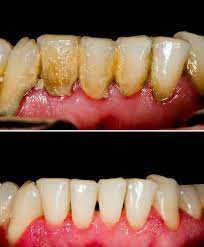When it comes to oral health, it is not all about the brightness of your teeth; your gums also matter. Without proper healthcare, bacterial growth in your mouth may lead to Union Square periodontal disease – an advanced form of gum disease, which destroys the fibers and bone holding your teeth, and may eventually cause tooth loss.
What is the difference between gingivitis and periodontitis?
Gingivitis is the earliest form of gum disease that affects your gums, causing them to become red, inflamed, tender, swollen, and prone to bleeding. These symptoms are usually mild, making it easy for someone to ignore them. While the gums may be irritated, your teeth are still secure in their sockets, and there is no bone or other tissue damage. However, when left unresolved, the bacteria in your mouth can destroy the fibers and bone supporting your teeth; this can impact your bite, and some of your teeth may need to be removed.
Causes of gum disease
Plaque, a sticky film of bacteria and food, is the main culprit for gum disease. It forms when you don’t brush and floss your teeth or rinse with antibacterial mouthwash. Plaque releases acids that attack the outer layer of your teeth (enamel), causing decay. Over time, the plaque hardens into tartar, making it hard to properly clean your teeth and gums. The bacteria in plaque irritate and inflame your gums, causing gingivitis, which can develop into periodontitis. If gingivitis advances to periodontitis, the inner layer of your gum recedes from your teeth, forming pockets that collect debris and can become infected.
Besides poor oral hygiene habits, periodontal disease can result from other factors. For example, hormonal changes during puberty, menstruation, pregnancy, and menopause increase gum sensitivity, increasing the risk of gingivitis. Certain illnesses can also affect the health of your gums; they include diseases like cancer or HIV that weaken your immune system. Diabetes also increases your risk of developing infections, including cavities and periodontal disease.
Gum disease may also be due to medications that lessen saliva flow, which protects your teeth and gums. You can also develop gum disease if you smoke since it makes it hard for gum tissue to repair itself.
What is the treatment for gum disease?
There are various treatment options, depending on the stage of the disease, how you have responded to past treatments and your overall health. Gum disease treatment aims to reduce gum inflammation, promote the reattachment of healthy gums to teeth, and stop disease progression. Treatment options range from nonsurgical therapies that stop bacterial growth to procedures that repair supportive tissues.
Nonsurgical treatments and professional dental cleanings; are usually part of the bi-annual routine checkups. However, if you have signs of gum disease, your dentist may recommend that you have frequent professional cleaning. During a professional cleaning, the dentist removes plaque and tartar above and below the gumline of your teeth. Other non-surgical treatments include scaling and root planing, and medications.
If the tissue around your teeth is unhealthy and can’t be repaired with nonsurgical options, your dentist may recommend flap surgery, bone grafting, soft tissue grafts, guided tissue regeneration, or bone surgery.
If you have inflamed gums, visit your dentist at LivWell Dentistry for treatment to avoid disease progression and improve your oral health.
